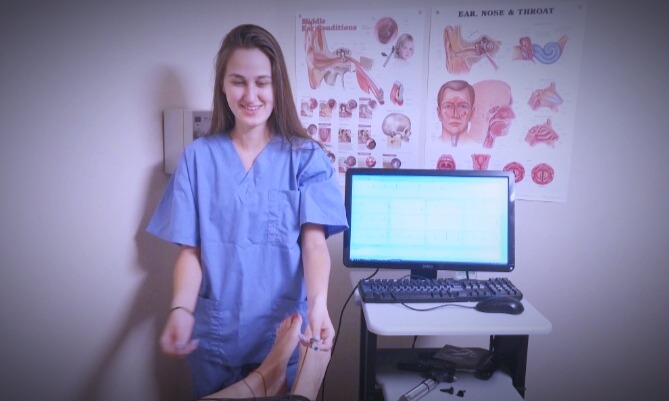ECG:
What is it?
An electrocardiogram — abbreviated as EKG or ECG — is a test that measures the electrical activity of the heartbeat. With each beat, an electrical impulse (or “wave”) travels through the heart. This wave causes the muscle to squeeze and pump blood from the heart. A normal heartbeat on ECG will show the timing of the top and lower chambers.
The right and left atria or upper chambers make the first wave called a “P wave” — following a flat line when the electrical impulse goes to the bottom chambers. The right and left bottom chambers or ventricles make the next wave called a “QRS complex.” The final wave or “T wave” represents electrical recovery or return to a resting state for the ventricles.
Why is it done?
An ECG gives two major kinds of information. First, by measuring time intervals on the ECG, a doctor can determine how long the electrical wave takes to pass through the heart. Finding out how long a wave takes to travel from one part of the heart to the next shows if the electrical activity is normal or slow, fast or irregular. Second, by measuring the amount of electrical activity passing through the heart muscle, a cardiologist may be able to find out if parts of the heart are too large or are overworked.
Does it hurt?
No. There’s no pain or risk associated with having an electrocardiogram. When the ECG stickers are removed, there may be some minor discomfort.
Is it harmful?
No. The machine only records the ECG. It doesn’t send electricity into the body.
Overview
What is it?
Spirometry is a common office test used to assess how well your lungs work by measuring how much air you inhale, how much you exhale and how quickly you exhale.
Spirometry is used to diagnose asthma, chronic obstructive pulmonary disease (COPD) and other conditions that affect breathing. Spirometry may also be used periodically to monitor your lung condition and check whether a treatment for a chronic lung condition is helping you breathe better.
Your doctor may suggest a spirometry test if he or she suspects your signs or symptoms may be caused by a chronic lung condition such as:
- Asthma
- COPD
- Chronic bronchitis
- Emphysema
- Pulmonary fibrosis
If you’ve already been diagnosed with a chronic lung disorder, spirometry may be used periodically to check how well your medications are working and whether your breathing problems are under control. Spirometry may be ordered before a planned surgery to check if your lung function is adequate for the rigors of an operation. Additionally, spirometry may be used to screen for occupational-related lung disorders.
Risks
Spirometry is generally a safe test. You may feel short of breath or dizzy for a moment after you perform the test.
Because the test requires some exertion, it isn’t performed if you’ve had a recent heart attack or some other heart condition. Rarely, the test triggers severe breathing problems.
How you prepare
Follow your doctor’s instructions about whether you should avoid use of inhaled breathing medications or other medications before the test. Other preparations include the following:
- Wear loose clothing that won’t interfere with your ability to take a deep breath.
- Avoid eating a large meal before your test, so it will be easier to breathe.
What you can expect
A spirometry test requires you to breathe into a tube attached to a machine called a spirometer. Before you do the test, a nurse, a technician or your doctor will give you specific instructions. Listen carefully and ask questions if something is not clear. Doing the test correctly is necessary for accurate and meaningful results.
In general, you can expect the following during a spirometry test:
- You’ll likely be seated during the test.
- A clip will be placed on your nose to keep your nostrils closed.
- You will take a deep breath and breathe out as hard as you can for several seconds into the tube. It’s important that your lips create a seal around the tube, so that no air leaks out.
- You’ll need to do the test at least three times to make sure your results are relatively consistent. If there is too much variation among the three outcomes, you may need to repeat the test again. The highest value among three close test results is used as the final result.
- The entire process usually takes less than 15 minutes.
Your doctor may give you an inhaled medication to open your lungs (bronchodilator) after the initial round of tests. You’ll need to wait 15 minutes and then do another set of measurements. Your doctor then can compare the results of the two measurements to see whether the bronchodilator improved your airflow.
